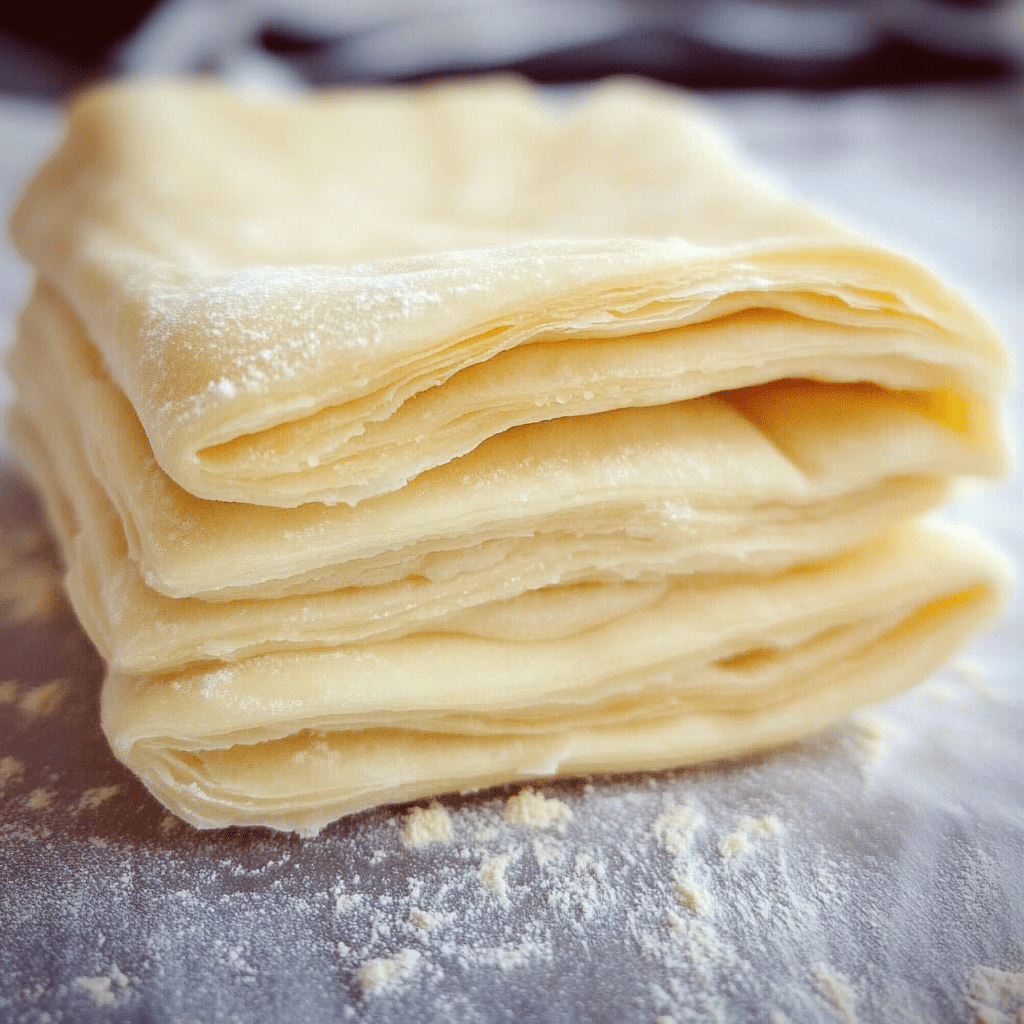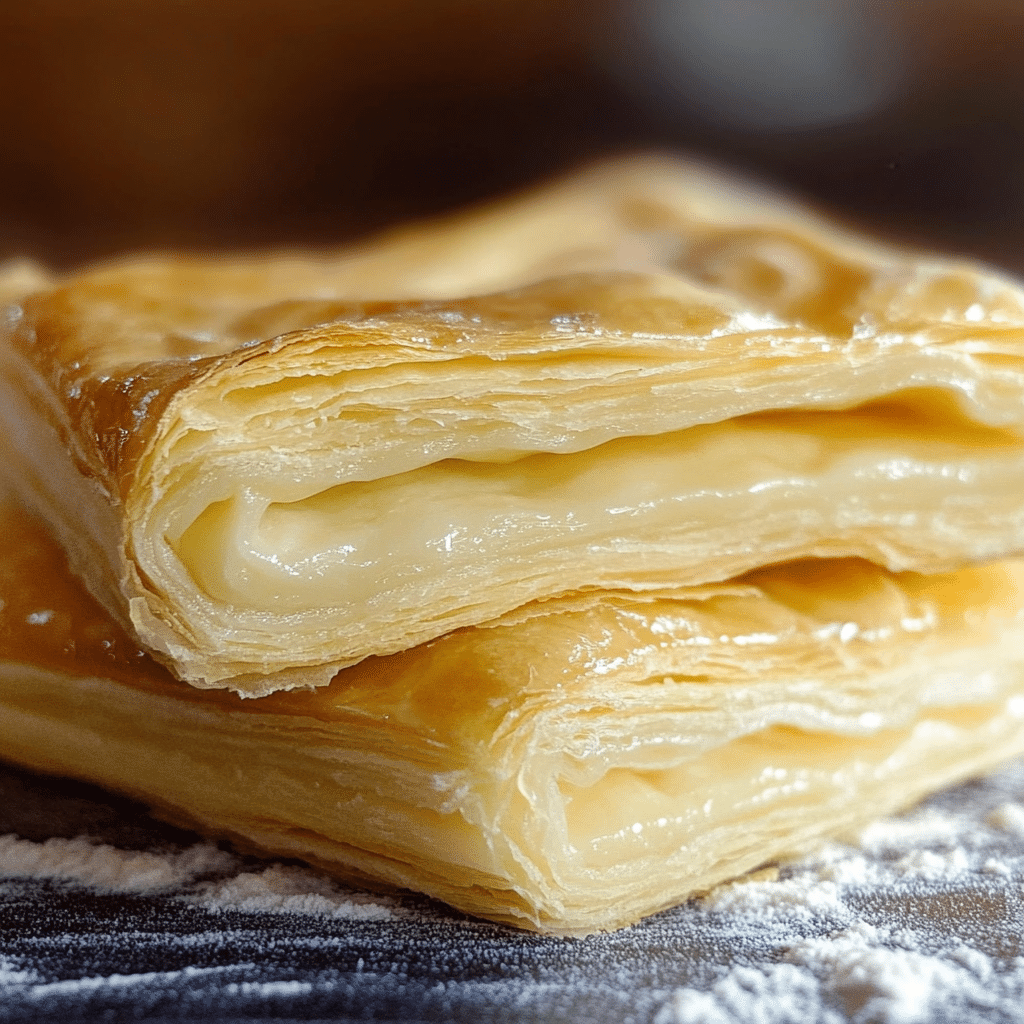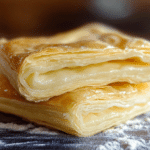Introduction
Puff Pastry Dough is a versatile and buttery dough that creates beautifully flaky layers when baked. This classic pastry is used to make a variety of delicious baked goods, from savory appetizers to sweet desserts. The magic of puff pastry lies in its many thin, crisp layers that puff up as the dough bakes, creating a light and airy texture.
I still remember the first time I made puff pastry from scratch. Watching the dough rise in the oven and seeing those perfect layers form was so satisfying. While it does require some time and effort, the results are well worth it. Plus, knowing you made it yourself adds a special touch to anything you bake.
The process involves layering butter and dough, then rolling and folding it repeatedly to create those signature flaky layers. Whether you’re crafting buttery croissants, elegant palmiers, or savory cheese straws, this dough delivers impressive results. And while store-bought puff pastry is convenient, there’s something extraordinary about the flavor and texture of homemade.
With the right techniques and a little patience, you can achieve professional-quality results in your own kitchen. Puff Pastry Dough is not just a recipe—it’s a skill that opens the door to endless baking possibilities!
Perfect for:
- Pastries, tarts, and pies
- Croissants and turnovers
- Appetizers like cheese straws
- Sweet treats like palmiers or mille-feuille
Why You’ll Love This Puff Pastry Dough
Here’s why making your own Puff Pastry Dough is worth the effort:
- Flaky Perfection: Homemade puff pastry delivers unmatched layers of buttery, flaky goodness.
- Customizable: You control the ingredients, ensuring a fresher and tastier dough.
- Versatile: Use it for a variety of recipes, both sweet and savory.
- Satisfying Process: There’s something deeply rewarding about mastering this classic baking skill.
Preparation and Resting Time
- Total Time: 4 hours (including resting time)
- Preparation Time: 30 minutes
- Resting Time: 3 ½ hours
- Servings: Makes about 1 ½ pounds of dough (enough for 2 large pastries or several smaller recipes)
- Calories per serving: Approximately 110 calories per ounce
- Key Nutrients: Carbs: 11g, Fat: 7g, Protein: 1g
Ingredients
To make Puff Pastry Dough, you’ll need:
For the Dough (Detrempe):
- 2 ½ cups (320g) all-purpose flour
- 1 teaspoon salt
- ½ cup (120ml) cold water
- 2 tablespoons unsalted butter, melted and slightly cooled
For the Butter Block (Beurrage):
- 1 cup (225g) unsalted butter, cold but pliable
- 2 tablespoons all-purpose flour (for dusting)
Ingredient Highlights
- Butter: High-quality unsalted butter is essential for creating rich, flaky layers.
- Flour: All-purpose flour provides structure while keeping the dough light.
- Cold Water: Ensures the dough stays cool, which is crucial for forming distinct layers.
- Salt: Enhances the flavor of the pastry without overpowering it.
Step-by-Step Instructions
Follow these steps to make Puff Pastry Dough:
Make the Dough (Detrempe):
- Mix the Ingredients: In a large mixing bowl, whisk together the flour and salt. Gradually add the cold water and melted butter, mixing until a rough dough forms.
- Knead the Dough: Turn the dough onto a lightly floured surface and knead gently for about 1-2 minutes until smooth. Do not over-knead.
- Shape and Chill: Shape the dough into a flat rectangle, wrap it tightly in plastic wrap, and refrigerate for 30 minutes.
Prepare the Butter Block (Beurrage):
- Prepare the Butter: Place the cold butter between two sheets of parchment paper. Use a rolling pin to gently flatten and shape it into a 6×6-inch square.
- Chill the Butter Block: Refrigerate the butter block for about 20 minutes, ensuring it remains pliable but not too hard.
Combine the Dough and Butter:
- Roll Out the Dough: On a floured surface, roll the chilled dough into a 10×10-inch square. Place the butter block in the center of the dough at a diagonal angle (like a diamond inside the square).
- Enclose the Butter: Fold the corners of the dough over the butter, meeting in the center, and pinch the seams to seal completely.
Laminate the Dough:
- First Roll and Fold (Turn 1): Roll the dough into a long rectangle (about 8×24 inches). Fold the dough into thirds, like a letter, and rotate it 90 degrees. This is the first turn. Chill the dough for 30 minutes.
- Repeat Rolling and Folding: Repeat the rolling, folding, and chilling process five more times (for a total of 6 turns), chilling the dough for 30 minutes between each turn. Keep the dough cool to maintain the butter layers.
- Final Chill: After the final turn, wrap the dough tightly in plastic wrap and refrigerate for at least 1 hour before using.

How to Serve Puff Pastry Dough
Once your Puff Pastry Dough is ready, you can use it in countless ways:
- Savory: Make quiches, pies, or cheese-filled appetizers.
- Sweet: Create croissants, palmiers, or fruit tarts.
- Creative: Use it as a crust for pot pies or as a base for mille-feuille.
Additional Tips for Puff Pastry Dough
Here are some tips to ensure your puff pastry turns out perfect:
- Keep It Cold: Always work with cold ingredients and chill the dough between turns to prevent the butter from melting.
- Don’t Overwork: Handle the dough gently to preserve the layers.
- Use Even Pressure: Roll the dough evenly to maintain consistent layers.
- Flour Lightly: Use just enough flour to prevent sticking, but don’t over-flour the surface.
- Chill Between Folds: After each fold, wrap the dough in plastic wrap and chill it for at least 30 minutes before continuing to allow the layers to set.
- Avoid Overfilling: When using puff pastry for savory or sweet fillings, avoid overfilling the dough as it may prevent the pastry from puffing up properly.
- Egg Wash for Shine: Brush the top of your puff pastry with a beaten egg before baking to achieve a golden, glossy finish.
- Prick with a Fork: For pastry that should not puff up too much (like tart bases), prick the dough lightly with a fork to allow steam to escape.
- Freeze for Easy Use: If you have extra dough, freeze it in a tightly sealed bag for later use. It will last for a few weeks and can be thawed overnight in the fridge.
- Baking on a Hot Pan: Preheat your baking sheet or tray to ensure that the puff pastry starts cooking immediately when placed on it, encouraging the layers to puff up beautifully.
Recipe Variations for Puff Pastry Dough
Here are 10 variations for Puff Pastry Dough:
- Whole Wheat Puff Pastry: Substitute half the all-purpose flour with whole wheat flour for a nuttier flavor.
- Gluten-Free Puff Pastry: Use a gluten-free flour blend designed for pastry.
- Herbed Puff Pastry: Mix chopped fresh herbs into the dough for added flavor.
- Cheese Puff Pastry: Sprinkle grated cheese over the dough before folding.
- Sweet Puff Pastry: Add a tablespoon of sugar to the dough for sweeter baked goods.
- Chocolate Puff Pastry: Sprinkle cocoa powder between layers for a chocolate-infused pastry.
- Spiced Puff Pastry: Add a pinch of cinnamon or nutmeg for a warm flavor.
- Laminated Dough with Shortening: Replace part of the butter with shortening for a slightly different texture.
- Vegan Puff Pastry: Use plant-based butter for a vegan-friendly version.
- Quick Puff Pastry: Skip a few turns and fold more quickly for a rough puff version.
Freezing and Storage for Puff Pastry Dough
- Freezing: Wrap the dough tightly in plastic wrap and place it in a freezer-safe bag. Store for up to 3 months. Thaw overnight in the refrigerator before using.
- Storage: Keep the dough in the refrigerator for up to 2 days. Always chill it before rolling or baking.
Special Equipment for Puff Pastry Dough
These tools will help you make the perfect Puff Pastry Dough:
- Rolling pin – Preferably a heavy-duty or French rolling pin for even rolling.
- Pastry scraper/bench scraper – To handle and shape the dough easily.
- Ruler or measuring guide – To ensure precise dimensions when rolling the dough.
- Silicone baking mat or pastry board – For a non-stick and easy-to-clean surface.
- Pastry brush – For brushing off excess flour or applying egg wash.
- Dough cutter or knife – For clean cuts when shaping or trimming the dough.
- Cooling rack – To allow finished pastries to cool evenly.
- Cling film (plastic wrap) – For chilling and resting the dough between folds.
- Food processor (optional) – For quickly blending the initial dough ingredients.
- Baking sheet with parchment paper – For baking the finished pastries.
Frequently Asked Questions for Puff Pastry Dough
- Can I make puff pastry ahead of time?
Yes, the dough can be refrigerated for up to 2 days or frozen for up to 3 months. - What if the butter leaks out during rolling?
Chill the dough immediately to firm up the butter and proceed gently. - How do I prevent the dough from sticking?
Use a lightly floured surface and rotate the dough while rolling. - Can I use salted butter?
You can, but reduce the salt in the dough recipe to balance the flavors. - What’s the difference between puff pastry and pie dough?
Puff pastry has multiple flaky layers created through laminating, while pie dough is a single-layer, crumbly crust.
Puff Pastry Dough
Puff Pastry Dough is a versatile and buttery dough that creates beautifully flaky layers when baked. This classic pastry is used to make a variety of delicious baked goods, from savory appetizers to sweet desserts. Making puff pastry from scratch may seem daunting, but with the right techniques and patience, you can achieve professional-quality results in your own kitchen.
- Prep Time: 30 minutes
- Resting Time: 3 ½ hours
- Total Time: 4 hours (including resting time)
- Yield: 1 ½ servings 1x
Ingredients
For the Dough (Detrempe):
- 2 ½ cups (320g) all-purpose flour
- 1 teaspoon salt
- ½ cup (120ml) cold water
- 2 tablespoons unsalted butter, melted and slightly cooled
For the Butter Block (Beurrage):
- 1 cup (225g) unsalted butter, cold but pliable
- 2 tablespoons all-purpose flour (for dusting)
Ingredient Highlights
- Butter: High-quality unsalted butter is essential for creating rich, flaky layers.
- Flour: All-purpose flour provides structure while keeping the dough light.
- Cold Water: Ensures the dough stays cool, which is crucial for forming distinct layers.
- Salt: Enhances the flavor of the pastry without overpowering it.
Instructions
Make the Dough (Detrempe):
- Mix the Ingredients: In a large mixing bowl, whisk together the flour and salt. Gradually add the cold water and melted butter, mixing until a rough dough forms.
- Knead the Dough: Turn the dough onto a lightly floured surface and knead gently for about 1-2 minutes until smooth. Do not over-knead.
- Shape and Chill: Shape the dough into a flat rectangle, wrap it tightly in plastic wrap, and refrigerate for 30 minutes.
Prepare the Butter Block (Beurrage):
- Prepare the Butter: Place the cold butter between two sheets of parchment paper. Use a rolling pin to gently flatten and shape it into a 6×6-inch square.
- Chill the Butter Block: Refrigerate the butter block for about 20 minutes, ensuring it remains pliable but not too hard.
Combine the Dough and Butter:
- Roll Out the Dough: On a floured surface, roll the chilled dough into a 10×10-inch square. Place the butter block in the center of the dough at a diagonal angle (like a diamond inside the square).
- Enclose the Butter: Fold the corners of the dough over the butter, meeting in the center, and pinch the seams to seal completely.
Laminate the Dough:
- First Roll and Fold (Turn 1): Roll the dough into a long rectangle (about 8×24 inches). Fold the dough into thirds, like a letter, and rotate it 90 degrees. This is the first turn. Chill the dough for 30 minutes.
- Repeat Rolling and Folding: Repeat the rolling, folding, and chilling process five more times (for a total of 6 turns), chilling the dough for 30 minutes between each turn. Keep the dough cool to maintain the butter layers.
- Final Chill: After the final turn, wrap the dough tightly in plastic wrap and refrigerate for at least 1 hour before using.
Nutrition
- Calories: 110 kcal
- Fat: 7g
- Carbohydrates: 11g
- Protein: 1g
Conclusion
Puff Pastry Dough is the foundation of many irresistible baked creations. With its light, buttery layers and melt-in-your-mouth texture, it’s a versatile staple for both sweet and savory recipes. Whether you’re making classic croissants, savory tarts, or indulgent desserts, this dough brings a touch of elegance to any dish.
This recipe requires patience and care, but the reward is a beautifully flaky pastry that’s well worth the effort. Perfect for everything from casual family meals to elaborate holiday spreads, puff pastry dough is a skill that every home baker will love mastering.
I’d love to see how your Puff Pastry Dough creations turn out! Snap a photo, share it on social media, and don’t forget to tag me—I can’t wait to see your delicious masterpieces. Happy baking!


